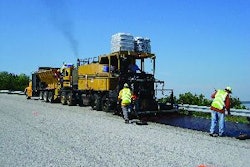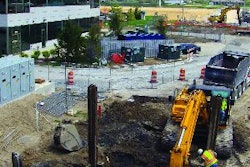It is incredibly difficult, and normally more expensive, to grow your business with only new business opportunities. Certainly word of mouth, an abundance of cash in the industry and being in the right place at the right time can always give any contractor a huge shot of growth. However, such good times don't always last, and when the economy tightens up those contractors who were "riding the crest" often find a very quick ending, sometimes even losing their businesses.
The key to long-term growth and to riding out the good and the not-so-good economic times can be accomplished by emphasizing the effort to gain repeat sales. While most contractors I have worked with through the years have all had a percentage of repeat customers, they have not always viewed that part of their marketing as anything in need of a more formal approach. Let me share with you a few tips that may gain you more work in the future from a greater percentage of your existing customers.
#1 Perform the "basics" well.
I'll just lump several items under this first technique: Offer a great finished project, provide A+ customer service, keep your customer informed and updated during the project, stay organized, clean up, etc. If you do not perform the "basics" well you'll never get a second job or referral.
#2 Ask the customer about future work.
Most contractors are lackadaisical when it comes to asking customers about future work opportunities. Asking about future work should not be something you just mention as you're walking away from the current project or an easy-to-overlook phrase you include in your last billing statement. If you have just performed A+ work then you should not be shy or subtle about inquiring about future work. Make it a point of conversation over coffee during a customer visit prior to the present job's completion and state boldly, "Mr. Smith, I really would like to do your next project."
#3 Recommend additional work opportunities.
Admittedly, some customers have little vision about future project needs. What may be hard for them to imagine might be crystal clear to you. It is a good technique to suggest to a client additional work that could be completed, what the work would do to add value to their existing property and what the cost of doing the work today might be compared to waiting. In some cases the customer is just not a construction- or development-minded individual and they may look to others, including you, to give them feedback that they were not aware of.
#4 Ask for referrals.
One measurement I think contractors should track is how much business they get through referrals. In a sense, this constitutes the same effort, with similar results, as repeat business with the same client. Making a contact with a referral almost mirrors the comfortable sales approach that might be experienced with the referring client. There is already a comfort level because of the relationship that exists between your client and the individual they referred you to. Often, the referral looks at such a contact as, "Well, if this contractor is good for ol' Charlie then he's good enough for me." Some referrals may not be quite that honest or open, but there is a better than 50 percent chance you will land more work because of the referral process.
#5 Introduce clients to other project results.
You can never stop selling your existing clients on work you perform. Even while you are performing current work for a client, take that client to other projects you are working on, especially those that may be similar in scope or complexity to something the client has discussed with you as needing completion. This effort keeps the pipeline open to discussing their future goals, vision, building needs, etc. It is also a way to reiterate to the client that you can do many things other than what you are performing for them on a single project.
#6 Ask your client to assist your budgeting process.
Inform your client that you are putting your budget together and need to ascertain how many crews you'll need or whether you may need to acquire additional equipment. This technique may be more appropriate for commercial clients, but I've actually seen it work for residential contractors who work for clients with larger properties or who hold multiple properties.
#7 Send a proposal for future work.
Many contractors have very close relationships with their clients and thus it would not be too presumptuous on their part to provide a proposal of future work. Certainly the proposal should reflect those conversations that have actually taken place between the contractor and client but might also include some of what was presented in #2 and #3. This technique simply formalizes some of the previous efforts, providing the client with something to hold on to, review and include in their own budgeting for future work.
#8 Build a strong relationship.
This final technique is something every successful contractor has done with existing clients. Look at every client individually and consider what type of relationship you want to have. Each of the previous techniques is driven by asking for something, but this technique is focused on building good relationships.
As contractors, our goal is not to become best friends with every client but to work to be better liked and appreciated. Think about the basics of being a friend. A friend tells it like it is, doesn't shy away from pointing out potential snags and pitfalls, prevents emergencies from taking place, and overall looks to keep a friend out of trouble. Most of the successful contractors I've had the privilege to work with and to know personally count many of their clients as friends. Some of these clients also count those contractors as their friends. They may not socialize very often, if at all, but there is a respect and appreciation for the relationship. Bottom line, most folks don't work with people they dislike.
Working hard at building repeat business takes time and sometimes a few bucks. But it still pales in comparison to trying to market for new work only. There is less game playing since both businesses are familiar with how the sales, building, and billing process works and are not shy about sharing their concerns. Most customers are looking for those contractors who can deliver what they propose, who treat them fairly and who can partner with them on future work if there is future work to be had.
Brad Humphrey is a president of Pinnacle Development Group, a consulting firm that specializes in the construction industry. For more information about this topic and others go to www.gangboxinc.com and find resources developed by Brad's firm specifically for the construction industry.


















